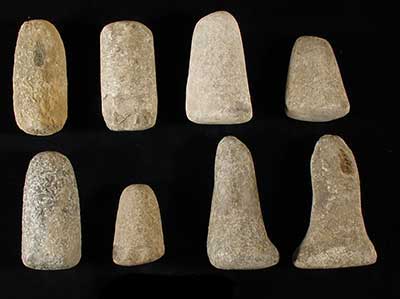Of the 216 diagnostic chipped stone tools recovered from the site, analysts classified 178 as Large Side Notched Raddatz spear points or hafted endscrapers. The relatively large number of Middle Archaic chipped stone tools from Baker, coupled with the thickness of the midden, reflect a post-ca. 5000 BC trend toward decreased hunter-gatherer mobility, and longer, more intensive occupation of resource-rich areas within the Green River drainage. Decreasing mobility also coincided with an increase in mussel shell collecting, and hickory nut and walnut processing.
Also of note was the recovery of 23 pestles from Baker. These objects are generally interpreted as having been used to process/crush seeds and nuts. Most were conical in shape, although a few were bell-shaped. These pestles tended to be made from limestone, but one example from Baker was made from granite.
